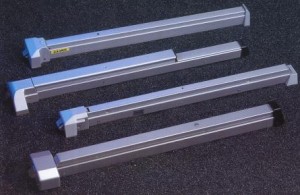 Although most Americans interact with panic bars nearly every day, and millions of lives have been saved by them, odds are most don’t even know what they are. You’ve most likely seen panic bars on fire exits and standard exits in many facilities with strict safety regulations such as factories, schools, and hospitals. Panic bars are the wide “door handles” spanning doors at waist height which are opened by pressing. They are expertly designed to allow as many people as possible to escape in emergency situations such as fires or other threats which may cause a panic.
Although most Americans interact with panic bars nearly every day, and millions of lives have been saved by them, odds are most don’t even know what they are. You’ve most likely seen panic bars on fire exits and standard exits in many facilities with strict safety regulations such as factories, schools, and hospitals. Panic bars are the wide “door handles” spanning doors at waist height which are opened by pressing. They are expertly designed to allow as many people as possible to escape in emergency situations such as fires or other threats which may cause a panic.
Painful Progress
The journey to safety, unfortunately, often begins with a catalyzing tragedy which shocks the masses into action and protest. One such event is the tragic Triangle Shirtwaist Fire of 1911 during which 146 workers perished due to unsafe business practices and exit construction. Factory owners violated or skirted many safety codes by building inward-opening exits and locking in workers. Pressure from a mass of people attempting escape a building often crushes individuals nearest to the door, rendering inward-opening exits unable to open. Inward-opening exits in the Triangle Shirtwaist factory were only permitted due to a technicality which the owners took advantage of to avoid paying for improvements.
Lessons Learned
This unfortunate confluence of unsafe design and harmful management practices had devastating effects. However, thanks to reform following the fire, door handles requiring fine wrist movement gave way to the panic bar, invented specifically to accommodate for, and respond to, the way crowds operate in panic situations, preventing crushing deaths and injuries, and allowing people to escape to safety.
